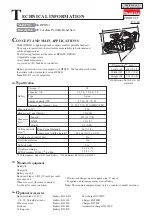
12 ENGLISH
ASSEMBLY
CAUTION:
Always be sure that the tool is
switched off and the battery cartridge is removed
before carrying out any work on the tool.
Installing or removing jig saw blade
CAUTION:
Always clean out all chips or for-
eign matter adhering to the jig saw blade and/or
blade holder.
Failure to do so may cause insufficient
tightening of the jig saw blade, resulting in a serious
personal injury.
CAUTION:
Do not touch the jig saw blade or
the workpiece immediately after operation.
They
may be extremely hot and could burn your skin.
CAUTION:
Always secure the jig saw blade
firmly.
Insufficient tightening of the jig saw blade may
cause the blade breakage or serious personal injury.
CAUTION:
Use only B type jig saw blades.
Using blades other than B type causes insufficient
tightening of the jig saw blade, resulting in a serious
personal injury.
CAUTION:
When you remove the jig saw
blade, be careful not to hurt your fingers with the
top of the jig saw blade or the tips of workpiece.
Before installing the jig saw blade, make sure that the
blade clamp lever is in the released position.
To install the jig saw blade, insert the jig saw blade
(teeth facing forward) into the jig saw blade holder. The
blade clamp lever moves to the fixed position and the
jig saw blade is locked. Make sure that the back edge
of the jig saw blade fits into the roller. Pull the jig saw
blade lightly to make sure that the jig saw blade does
not fall off during operation.
►
Fig.7:
1.
Jig saw blade holder
2.
Blade clamp lever
(released position)
3.
Blade clamp lever
(fixed position)
►
Fig.8:
1.
Jig saw blade holder
2.
Jig saw blade
3.
Roller
CAUTION:
If the blade clamp lever does not
move to the fixed position, the jig saw blade is
not installed completely. Do not press the blade
clamp lever by hand to the fixed position. It may
damage the tool.
To remove the jig saw blade, push the blade clamp lever
forward as far as it will go. This allows the jig saw blade
to be released.
►
Fig.9:
1.
Jig saw blade holder
2.
Blade clamp lever
3.
Jig saw blade
NOTE:
If it is difficult to remove the jig saw blade, turn
the cutting action changing lever to the position "III"
and move the jig saw blade holder to the bottom. To
move the jig saw blade holder to the bottom, return
the blade clamp lever fully to the fixed position once
and slightly switch on the tool several times.
NOTE:
Occasionally lubricate the roller.
Hex wrench storage
When not in use, store the hex wrench as shown in the
figure to keep it from being lost.
►
Fig.10:
1.
Hex wrench
OPERATION
CAUTION:
Always hold the base flush with
the workpiece.
Failure to do so may cause jig saw
blade breakage, resulting in a serious injury.
CAUTION:
Advance the tool very slowly when
cutting curves or scrolling.
Forcing the tool may
cause a slanted cutting surface and jig saw blade
breakage.
Turn the tool on without the jig saw blade making any
contact and wait until the jig saw blade attains full
speed. Then rest the base flat on the workpiece and
gently move the tool forward along the previously
marked cutting line.
►
Fig.11:
1.
Cutting line
2.
Base
Bevel cutting
CAUTION:
Always be sure that the tool is
switched off and the battery cartridge is removed
before tilting the base.
With the base tilted, you can make bevel cuts at any
angle between 0° and 45° (left or right).
►
Fig.12
Loosen the bolt on the back of the base with the hex
wrench. Move the base so that the bolt is positioned in
the center of the cross-shaped slot in the base.
►
Fig.13:
1.
Hex wrench
2.
Bolt
3.
Base
Tilt the base until the desired bevel angle is obtained.
The edge of the motor housing indicates the bevel
angle by graduations. Then tighten the bolt to secure
the base.
►
Fig.14:
1.
Edge
2.
Graduation
Front flush cuts
Loosen the bolt on the bottom of the base with the
hex wrench and slide the base all the way back. Then
tighten the bolt to secure the base.
►
Fig.15:
1.
Hex wrench
2.
Bolt
3.
Base
Cutouts
Cutouts can be made with either of two methods:
“Boring a starting hole” or “Plunge cutting”.
Boring a starting hole
For internal cutouts without a lead-in cut from an edge,
pre-drill a starting hole 12 mm or more in diameter.
Insert the jig saw blade into this hole to start your cut.
►
Fig.16
Summary of Contents for DJV185Z
Page 2: ...2 1 2 3 Fig 1 1 2 Fig 2 1 Fig 3 1 2 Fig 4 1 2 Fig 5 1 Fig 6 1 3 2 Fig 7 ...
Page 3: ...3 1 2 3 Fig 8 1 2 3 Fig 9 1 Fig 10 2 1 Fig 11 Fig 12 3 2 1 Fig 13 2 1 Fig 14 ...
Page 4: ...4 3 2 1 Fig 15 Fig 16 Fig 17 Fig 18 1 Fig 19 1 Fig 20 ...
Page 5: ...5 1 Fig 21 1 2 Fig 22 Fig 23 1 Fig 24 1 2 3 Fig 25 1 Fig 26 4 3 1 2 5 Fig 27 1 2 Fig 28 ...













































